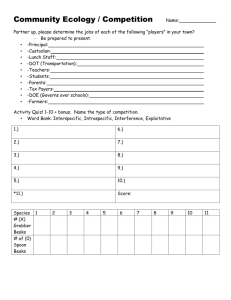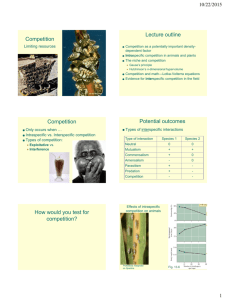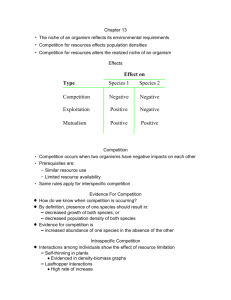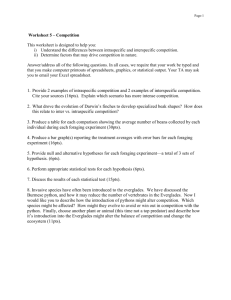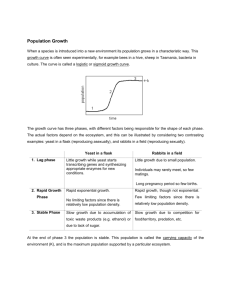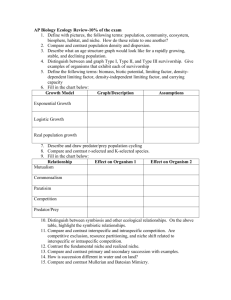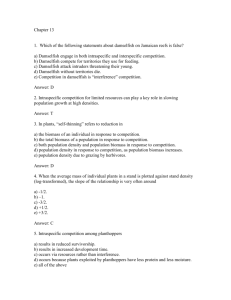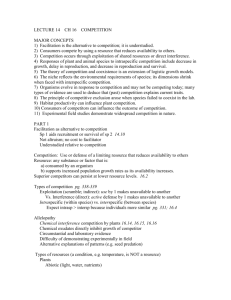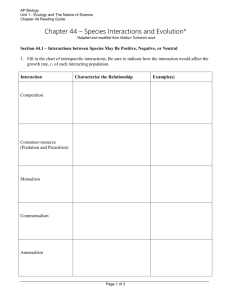Biology of Competition
advertisement
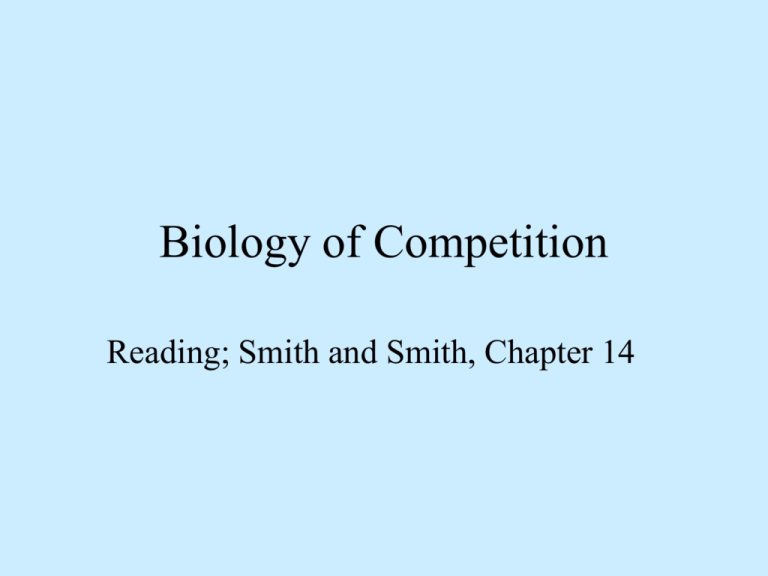
Biology of Competition Reading; Smith and Smith, Chapter 14 Question; Why are we so quick to blame the zebra mussel? • 19th century ecologists documented that closely related species living in the same general area seem to prefer slightly different habitats. • The role of interspecific competition in the formation of communities was suspected-after all, there seemed to be no reason why small differences in environment would prevent either species from growing on both types of habitat. • Tansley’s (1917) common garden experiment; – worked with 2 closely related bedstraw, Gallium saxatile and G. sylvestre. – Planted each alone in both types of habitat, then planted both together in each type of habitat. ResultEach species competes best on its “own” type of soil. G. saxatile-acid soil G. sylvestrecalcareous soil. Tansley’s study illustrates competition as a valid mechanism for organizing communities Competition • Competition is the use of a resource by one organism that reduces the availability of that resource to other organisms. – Competition is thought to be ubiquitous in nature, both as an agent of natural selection and a factor structuring communities. – For competition occur: • both organisms must use a common resource that is important to their survivorship and reproduction • that resource must be limited-use by one individual must decrease what is available to others in a meaningful way • Not a limiting resource, example-Oxygen is essential to the metabolism of most animals, yet in terrestrial environments, the use of oxygen by individuals of one species does not significantly depress the amount of oxygen available to other species (or other individuals of the same species)although essential for animal life, oxygen diffuses too fast/regenerates too fast to become an important limiting resource. • Some possible limiting resources– plants-light, water, nutrients, space, pollinators – animals-prey, nesting sites, territories, water, host organisms, space (sessile organisms), mates (intraspecific only) Limiting resources, example-within the appropriate intertidal region, space is a very important limiting resource. Once it is used up, individuals can only settle and grow at the expense of others • Intraspecific Competition: Competition among members of the same species for an important, limiting resource • Interspecific Competition: Competition among members of different species for an important, limiting resource Types of Competition • Exploitation Competition-one species denies another access to a resource simply by consuming it first. • Interference Competition-one species actively inhibits the foraging, survival, or reproduction of the other species – I.e., chemical, behavioral • Preemptive Competition-one species denies another access simply by getting there first. – Also, overgrowth competition – territoriality Consequences of Competition • Coexistence • Exclusion of one species Exclusion • The phenomenon of competitive exclusion was first documented experimentally by the Russian biologist C. F. Gause. – Gause’s experiment is now quite famous – P. caudatum is larger than P. aurellia, but has a slower reproductive rate. Both species consume bacteria via a “funnel” lined with cilia. – Gause grew each species alone, in a culture where a fixed amount of food (bacteria) was added each day. – He then grew the two species together. His result was the exclusion of P. caudatum by P. aurellia. He hypothesized that the two species compete for the same foodultimately P. aurellia is ultimately able to multiply under conditions where P. caudatum can no longer gain enough energy to divide. This is called competitive exclusion • Gause’s experiment was tremendously influential. Based on this, and other experiments, ecologists arrived at the competitive exclusion principle, which is now firmly established. – Two species cannot exist on the same limiting resource indefinitely-ultimately, even a slight reproductive advantage to one of them will result in their displacing the other. – In terms of the niche-if the niches of two species overlap completely, only the superior competitor can survive. • Ironically, this experiment gives different results, depending upon which strains of Paramecium are used-some strains coexist, presumably by partitioning the limiting resource (bacteria). Example of Competitive • Aphytis vs. Aphytis Exclusion – The California red scale insect attacks citrus trees. – It is a serious economic pest in Southern California, and has evolved resistance to pesticide. – Adults live under waxy sheaths, and are protected from many generalist predators as well • Parasitoids of the genus Aphytis attack scale insects – Aphytis chrysomphai was accidentally introduced to CA. • Despite imposing severe mortality, it did not control the population-especially in dry valleys. – A linganensis was introduced from China in 1950. • It replaced A. chrysomphai within a decade-its higher reproductive rate may have been a factor. – In interior valleys, scale insects were still a problem • Cold temps kill A. linganensis. Example of Coexistence via Niche Partitioning • A cold tolerant species, A. melinus was introduced from Pakistan in 1957 – A. melinus quickly spread throughout the valleys, but did not displace A.linganensis from coastal regions. – The two species coexist today, providing very good protection against red scale-they have partitioned the habitat based on winter temperatures. The Lotka-Volterra Model of Competition • The Lotka-Volterra model of competition starts with the logistic equation, and adds a term to account for interspecific competition as well as the intraspecific competition inherent in the original model. – It has some interesting dynamics, and makes predictions about the conditions necessary for species to coexist. – Thus:dN1/dt=r1N1(K1-N1-a12N2) • dN2/dt=r2N2(K2-N2 -a21N1) – where • N1=Population of Species 1 • N2=Population of Species 2 • K1=Carrying Capacity of Species 1 • K2=Carrying Capacity of Species 2 a12=Effect of Species 2 on Species 1 a21=Effect of Species 1 on Species 2 The presence of an interspecific competitor lowers the equilibrium density of a species below its original carrying capacity – Consider the populations of two species plotted on the X and Y axes respectively. • For the species on the X axis, (Sp 1) a diagonal line can be drawn. This is an isocline. • To the right of it, species 1 will decrease in number, to the left of it, species 1 will increase in number. Interspecific competition alone stops growth of species 1 Some combination of the two stops population growth of species 1 Intraspecific competition alone stops population growth of sp 1 – Likewise, for the species on the Y axis (Sp 2), an isocline can be drawn. – Above it, species 2 will decrease in number, below it, species 2 will increase in number. K2 K2/a21 – Notice, this particular pair of isoclines, there is one area where species 1 increases and species 2 decreases, and one area where the reverse is true K2 here here K2/a21 – Thus, a stable equilibrium exists where the two species can coexist K2 here K2/a21 In all these cases, interspecific competition is less severe than intraspecific competition I.e., K1/a12>K2 and K2/a21>K1 • If the reverse is true-I.e., interspecific competition is more severe than intraspecific competition, then the equilibrium is unstable-only 1 species survives, but it can be either one • Or, the contest can be totally unequal. If the isocline of 1 species lies above the isocline of the other, then that species wins-it excludes the other. Predictions • Alhough somewhat abstract, and very simple, the Lotka-Volterra model makes interesting predictionssome of which are testable. – In theory, both alpha and K are measurable. • Case 4 • Case 3 • In cases where one competitor excludes the other, the dominant competitor should be the species that can grow under conditions where the limiting resource is too scarce for the other species to grow – -e.g.-it is not the species with the higher r that wins, it is the species with the higher isocline based on carrying capacity. Case 2 Laboratory Experiments • Competition has been studied in laboratory experiments on a wide variety of plants, animals, and protists. • For practical reasons, these experiments have been carried out in small, simple environments, and on small, r-selected organisms (the kind least likely to suffer high levels of competition under natural conditions) Tribolium Competition • Thomas park worked on competition in two closely related species of flour beetles, Tribolium castaneum and Tribolium confusum. – Both species infest stored flour products. – This is a very challenging environment, with unlimited carbohydrates, but limited protein and extremely limited moisture. • When cultures were started with equal numbers of founders from each species; – T. castaneum always displaced T. confusum under moister, or warmer conditions. – T. confusum always displaced T. castaneum under colder, or drier conditions. – Under intermediate conditions, the outcome could not be predicted-only 1 species persisted, but it could be either one. • Park referred to this as the indeterminate zone. – Other experiments showed that an intercellular parasite, Wolbacchia sp., could reverse the outcome of competition. Starting number was also important if cultures were started with unequal numbers of beetles, it predisposed that species to outcompete the other. • In the case of flour beetles, both species compete strongly for moisture, and one of the most important mechanisms for competition is egg cannibalism. – The larvae of both species eat the eggs of their own species, as well as the other. – This is a form of interference competition which exerts very strong interspecific and intraspecific effects. – Different strains differ in their propensity for cannibalism-and thus differ in competitive ability • kin selection on some strains has actually decreased cannibalism-decreasing their competitive ability in mixed cultures Field Experiments on Competition • Some of the best studies of competition have been “field” studies. These are conducted under more natural conditions, with actual populations of wild animals. – Although much more representative of the evolutionary processes that actually occur in nature, field studies of competition have their own drawbacks. • They are difficult to replicate-weather, local conditions, and genetic features of the populations in question might influence the outcome. • Philosophical issues-nobody sets out to look for the absence of something-there might be a selection bias toward choosing scenarios where competition is especially intense. • Geko vs. Geko in an Aircraft Hangar “Cage Match” – Many species of nocturnal gekos eat essentially the same insect prey. – In Polynesia, introduced, sexual species of geko tend to displace the native, parthogenic species. – Petren and Case studied competition among native and introduced gekos in aircraft hangars on Oahu, left over from WWII. • These aircraft hangars were quite similar-in some ways they were as close as possible to experimental replicates. • Different hangars were fitted with arrays of lights (gekos forage for insects near lights at night) and barriers, to create variable amounts of environmental complexity – “simple hangars”-one fixed light source, few barriers – “complex hangars”-many light sources, many barriers • Researchers measured the behavior, and the body condition of the gekos. – In the absence of habitat structure, their niches overlap a great deal, and the house geko Hemidactylus frenatus outcompetes the others. – When habitats are structured by vegetation, rocks, etc., space (and the food within) is partitioned, and interspecific competition is reduced enough to allow possible coexistence H. frenatus H. mabouia Predation and Competition • The presence of predators can have enormous potential effects on the outcome of competition. • This effect is best known from the experiments of Paine et al., who studied intertidal communities in California. – Rocky coasts in California harbor an enormous number of plant and animal species, including mussels, gooseneck barnacles, barnacles, limpets, chitons,and various algae, all of which compete for space – The starfish, Pisaster sp. is the dominant predator. • Paine chose 2 areas – in one area, 8m long and 2 m deep, he removed all sea stars – in the other area (the control), he did not remove sea stars. Whelks Pisaster ochreu Mytillus sp. mussels • Result-in the sea star removal area, the number of species decreased rapidly, till eventually a single species of mussel dominated-the number of invertebrate species dropped from 15 to 8, and most of the rock surface was covered with mussels. Competition, Niche Breadth and Evolution • Competition is thought to be an important force in organizing biological communities, and an important cause of natural selection. • In the “assembly” of natural communities, only groups of competing species that can coexist by resource partitioning can coexist-sometimes this coexistence is mediated by a predator. – The addition of a new species may cause a series of extinctions, as competitive relationships differ, and food sources for higher trophic levels disappear. • In evolutionary terms, many pairs of conspecifics are expected to have evolved to minimize interspecific competition. An example of niche partitioning; Mojave Desert flora • Body Size – Size differences between closely related sympatric species have been implicated as being necessary for coexistence – In the "assembly" of communities, the most likely species to coexist will generally differ in body size, and thus exploit different habitats/prey/resources. – There may be a definite limit on how similar two competitors can be and still avoid competitive exclusion; • character displacement in average mouthpart sizes is often about 1.3, and the length ratio of 1.3 has been suggested as a crude estimate of just how different two species must be to coexist syntopically. Lizards • Pianka and others have studied assemblages of lizard species. – Most lizards are generalized predators, and lizards of similar size might be expected to compete for the same prey. • The comparative method was used-this is common in evolutionary biology-an actual group of already-extant lizards is compared with the expectations of theory, as an implied experiment. • 24 species of Australian Varanus were estimated for head length. Australia's largest lizard, Varanus giganteus (2 meters long). Varanus brevicata • Ratios of larger/smaller for all possible pairs of species were computed (N = 276) and a cumulative frequency distribution assembled. – This represents a null model of expected size ratios against which distributions of ratios in observed assemblages can be compared. • In real assemblages, there are many more high Hutchinsonian ratios than expected in random subsamples drawn from the species pool of all Australian varanids – Such high Hutchinsonian ratios suggest that either size assortment or character displacement has resulted in extant assemblages that differ in size. Australian Varanids Character Displacement and Ecological Release • Character displacement is an evolutionary response to competition. • Populations of a species with an interspecific competitor often tend to evolve in such a way as to be different in their resource utilization. – Some evolutionary biologists think of competition as a “transient phenomenon” -evolution tends to lead to its disappearance, although ecological studies tend to indicate that there is plenty of competition going on right now. • The opposite of character displacement is called “ecological release”-in an isolated environment with no competitors, a species will frequently evolve a broader range of resource use than before. Ecological Release on Islands • Evidence for ecological release comes from studies on so-called "incomplete" biotas, such as islands, where all of the usual species are not present. – Those species that invade such areas often expand their niches and exploit new habitats and resources that are normally exploited by other species on areas with more complete faunas. – On the island of Bermuda, considerably fewer species of land birds occur than on the mainland, with the three most abundant being the cardinal, catbird, and white-eyed vireo. • Crowell found that, compared with the mainland, these three species are much more abundant on Bermuda and that they occur in a wider range of habitats. • In addition, all three have somewhat different feeding habits on the island, and one species at least (the vireo) employs a greater variety of foraging techniques. Bermudan Birds
